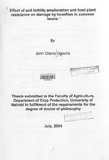| dc.description.abstract | Field and pot studies were conducted between 2000 and 2002 at Kenya
Agricultural Research Institute (KARl) Kisii and the University of Nairobi, Kabete
Campus Field Station to asses the effect of fertilizer application on the population
dynamics of bean-flies (Ophyiomyia spp) (Dipetera: Agromyzidae), damage on
plants and growth, yield and chemical composition of two resistant (EXL52 and
G8047) and one susceptible (GLP2) common bean varieties (Phaseolus vulgaris
L.). Eight fertilizer regimes were applied during planting. Treatments consisted
of Farm yard manure at 5 ton and 10 ton/ha, P20sat 25 and 50 kg/ha, (NH4hS04
at 35 and 75 kg/ha, Ca(N03h at 35 and 75 kg/ha and no fertilizer. Infester bean
rows of a susceptible variety ~ere planted a week earlier to build up bean fly
population. Seven bean genotypes were further evaluated to determine
mechanism for tolerance to low P- fertility conditions and bean fly.
The cultivars were Significantly different in bean fly infestation, growth, damage
and grain yield. The resistant EXL 52 had lower number of larvae and pupae
combined per plant than the susceptible GLP2. Percent total plant mortality was
significantly lower on EXL 52 and G8047 on susceptible GLP2. Highest grain
yield (1596.7kg/ha and 1337.3 kg/ha) were recorded on EXL52 and G8047 at
Kisii and at Kabete respectively.
Resistant (EXL52) and susceptible (GLP2) cultivars that received phosphorus
fertilizer at the rate of 50 kg/ha as TSP had improved growth and grain yield compared to the same cultivars in the control plots. This was attributed to
reduced plant mortality by bean fly. Increase in internode length, leaf size and dry
weight resulted in increased bean fly population density and plant damage. Plant
mortalities were positively correlated to bean fly numbers ( r=0.7, P s 0.05) but
were negatively related to the levels of N,P, K and polyphenol. Total plant
mortality and mortality due to bean fly were lower on resistant EXl52 and G8047
than susceptible GLP2 in plots treated with half the rate of phosphorus fertilizer
(25kg/ha as TSP) at Kabete site. Neither of the cultivars showed any relationship
between the levels of N,P,K and polyphenols with bean fly numbers suggesting
that beanflies, indirectly caused damage by the openings made in the epidermis
through which disease causing pathogens gained entry in the plants resulting in
mortality. Bean fly tolerant genotypes exhibited greater dry weight, which was
positively correlated to P uptake. It is concluded that the management of
beanflies through cultivar selection and plant nutrition can reduce mortality of
bean plants. Screening for plant resistance and the development of integrated
pest management strategies for beanfly should be location specific and varies
with season. Furthermore incorporation of genes for efficiency in P-uptake traits
in future bean germplasm improvement programme and their integration in
farming systems as part of strategies to addressing beanfly and soil fertility
constraints would greatly reduce excessive fertilizer use and nutrient load in the
water bodies. | en |

